Ecosystem Services and Their Relationships in the Grain-for-Green Programme—A Case Study of Duolun County in Inner Mongolia, China
Abstract
1. Introduction
2. Materials and Methods
2.1. Study Area
2.2. Data Sources
2.3. Quantification of Ecosystem Services
2.3.1. NPP
2.3.2. Potential NPP
2.3.3. Soil Conservation
2.3.4. Water Yield
2.3.5. Sandstorm Prevention
2.4. Relationships among ESs
2.4.1. Identification of ES Trade-Offs and Synergies
2.4.2. Statistical Analyses
2.4.3. Quantification of ES Tradeoff Strengths
3. Results
3.1. Changes in Land use and Vegetation Coverage
3.1.1. Changes in Land use
3.1.2. Changes in Vegetation Coverage
3.2. Changes in ESs
3.3. Correlation Coefficients between ESs in Duolun County
3.4. NPP of Duolun County
4. Discussion
4.1. Impact of the GFGP on ESs
4.1.1. Differences in ESs between Restored Grasslands and Unrestored Areas
- (1)
- Comparison of the ESs provided by restored grasslands and high-coverage grasslands with a steepness less than 5 degrees;
- (2)
- Comparison of the ESs provided by farmland and high-coverage grasslands with a steepness less than 5 degrees;
4.1.2. Correlation Analysis between Vegetation Coverage and ESs
4.2. The Relative Effects of Climate Change and GFGP Policies
4.3. Impacts of Vegetation on ES Tradeoffs
- (1)
- According to the division of sub-watersheds in Duolun County (Figure 8-Left), four sub-watersheds occupied by different proportions of vegetation types were selected to compare trade-off strengths using the PPF curve method;
- (2)
- Using the RMSE method, we quantified the strength of ESs trade-offs in farmland versus grassland with different vegetation coverage.
4.3.1. Effect of Different Vegetation Types on the Strength of ES Trade-Offs
4.3.2. Effect of Different Vegetation Coverage on the Strength of ES Trade-Offs
4.4. Advices for Future Policies
5. Conclusions
Author Contributions
Funding
Acknowledgments
Conflicts of Interest
References
- Costanza, R. The value of the world’s ecosystem services and nature capital. Nature 1997, 387, 253–260. [Google Scholar] [CrossRef]
- Daily, G.C. Nature’s services: Societal dependence on natural ecosystems. Pac. Conserv. Biol. 1997, 6, 220–221. [Google Scholar]
- Dai, E.; Wang, X.; Zhu, J.; Zhao, D. Ecosystem service Tradeoffs: Methods, Models and Research Framework. Geogr. Res. 2016, 35, 1005–1016. [Google Scholar]
- Ren, Y.; Lü, Y.; Fu, B. Quantifying the impacts of grassland restoration on biodiversity and ecosystem services in China: A meta-analysis. Ecol. Eng. 2016, 95, 542–550. [Google Scholar] [CrossRef]
- Lu, Q.; Xu, B.; Liang, F.; Gao, Z.; Ning, J. Influences of the Grain-for-Green project on grain security in southern China. Ecol. Indic. 2013, 34, 616–622. [Google Scholar] [CrossRef]
- Mu, S.; Zhu, C.; Zhou, K.; Li, J. Study on the countermeasures for grassland degradation and carbon increase in Inner Mongolia. Acta Acad. Sin. 2017, 25, 217–225. [Google Scholar]
- Zeng, Z.; Bi, J.; Li, S.; Chen, S.; Pike, D.; Gao, Y.; Du, W. Effects of habitat alteration on lizard community and food web structure in a desert steppe ecosystem. Biol. Conserv. 2014, 179, 86–92. [Google Scholar] [CrossRef]
- Jiang, G.; Han, X.; Wu, J. Restoration and management of the Inner Mongolia grassland require a sustainable strategy. Ambio 2006, 35, 269. [Google Scholar] [CrossRef] [PubMed]
- Unkovich, M.; Nan, Z. Problems and prospects of grassland agroecosystems in western China. Agric. Ecosyst. Environ. 2008, 124, 1–2. [Google Scholar] [CrossRef]
- Liu, J.; Diamond, J. China’s environment in a globalizing world. Nature 2005, 435, 1179. [Google Scholar] [CrossRef] [PubMed]
- Liu, J.; Li, S.; Ouyang, Z.; Tam, C.; Chen, X. Ecological and socioeconomic effects of China’s policies for ecosystem services. Proc. Natl. Acad. Sci. USA 2008, 105, 9477. [Google Scholar] [CrossRef] [PubMed]
- Deng, L.; Liu, S.; Kim, D.; Peng, C.; Sweeney, S.; Shangguan, Z. Past and future carbon sequestration benefits of China’s grain for green program. Glob. Environ. Chang. 2017, 47, 13–20. [Google Scholar] [CrossRef]
- Feng, X.; Fu, B.; Lu, N.; Zeng, Y.; Wu, B. How ecological restoration alters ecosystem services: An analysis of carbon sequestration in China’s Loess Plateau. Sci. Rep. 2013, 3 Pt 1, 2846. [Google Scholar] [CrossRef]
- Wang, J.; Peng, J.; Zhao, M.; Liu, Y.; Chen, Y. Significant trade-off for the impact of Grain-for-Green Programme on ecosystem services in North-western Yunnan, China. Sci. Total Environ. 2017, 574, 57–64. [Google Scholar] [CrossRef] [PubMed]
- Deng, L.; Shangguan, Z.; Li, R. Effects of the grain-for-green program on soil erosion in China. International J. Sediment Res. 2012, 27, 120–127. [Google Scholar] [CrossRef]
- Gong, G.; Liu, J.; Shao, Q. RWEQ-based research on wind erosion of soil in Xilin Hot of Inner Mongolia since the 1990s. Adv. Geogr. 2014, 33, 825–834. [Google Scholar]
- Cao, S.; Tian, T.; Chen, L.; Dong, X.; Yu, X.; Wang, G. Damage Caused to the Environment by Reforestation Policies in Arid and Semi-Arid Areas of China. Ambio 2010, 39, 279–283. [Google Scholar] [CrossRef] [PubMed]
- Rodríguez, J.; Beard, T.; Bennett, E.; Cumming, G.; Cork, S.; Agard, J.; Dobson, A.; Peterson, G. Trade-offs across Space, Time, and Ecosystem Services. Ecol. Soc. 2006, 11, 709–723. [Google Scholar] [CrossRef]
- D’Amato, A.; Bradford, J.; Fraver, S.; Palik, B. Forest management for mitigation and adaptation to climate change: Insights from long-term silviculture experiments. Forest Ecol. Manag. 2011, 262, 803–816. [Google Scholar] [CrossRef]
- Dickie, I.A.; Yeates, G.W.; St. John, M.G.; Stevenson, B.A.; Scott, J.T.; Pillig, M.C.; Peltzer, D.A.; Orwin, K.H.; Kirschbaum, M.U.F.; Hunt, J.E.; et al. Ecosystem service and biodiversity trade-offs in two woody successions. J. Appl. Ecol. 2011, 48, 926–934. [Google Scholar] [CrossRef]
- Zheng, H.; Li, Y.; Ouyang, Z.; Luo, Y. Research progress on the management of ecosystem service functions. Chin. J. Ecol. 2013, 33, 702–710. [Google Scholar]
- Jia, X.; Fu, B.; Feng, X.; Hou, G.; Liu, Y.; Wang, X. The tradeoff and synergy between ecosystem services in the Grain-for-Green areas in Northern Shaanxi, China. Ecol. Indic. 2014, 43, 103–113. [Google Scholar] [CrossRef]
- Lü, Y.; Fu, B.; Feng, X.; Zeng, Y.; Liu, Y.; Chang, R.; Sun, G.; Wu, B. A policy-driven large scale ecological restoration: Quantifying ecosystem services changes in the Loess Plateau of China. PLoS ONE 2012, 7, e31782. [Google Scholar] [CrossRef] [PubMed]
- Su, C.; Fu, B. Evolution of ecosystem services in the Chinese Loess Plateau under climatic and landuse changes. Glob. Planet. Chang. 2013, 101, 119–128. [Google Scholar] [CrossRef]
- Yang, W.; Jin, Y.; Sun, T.; Yang, Z.; Cai, Y.; Yi, Y. Trade-offs among ecosystem services in coastal wetlands under the effects of reclamation activities. Ecol. Indic. 2017, 92, 354–366. [Google Scholar] [CrossRef]
- Feng, Q.; Zhao, W.; Fu, B.; Ding, J.; Wang, S. Ecosystem service trade-offs and their influencing factors: A case study in the Loess Plateau of China. Sci. Total Environ. 2017, 607, 1250–1263. [Google Scholar] [CrossRef] [PubMed]
- Wu, X.; Wang, S.; Fu, B.; Liu, Y.; Zhu, Y. Landuse optimization based on ecosystem service assessment: A case study in the Yanhe watershed. Landuse Policy 2018, 72, 303–312. [Google Scholar] [CrossRef]
- He, Y.; Zhao, M.; Wang, J.; Zhang, H. Response of prairie productivity to climatic factors in the farming-pastoral ecotone of Inner Mongolia: A case study in Duolun County. J. Arid Meteorol. 2008, 26, 84–89. [Google Scholar]
- Jiang, G.; Liu, M.; Niu, S.; Li, Y.; Peng, Y.; Li, G.; Su, B. Review and prospect of ecological restoration in Hunshandake Sandy Land over 10 years. Sci. Technol. Rev. 2011, 29, 19–25. [Google Scholar]
- Dai, L.; Che, T.; Wang, J.; Zhang, P. Snow depth and snow water equivalent estimation from AMSR-E data based on a priori snow characteristics in Xinjiang, China (EI). Remote Sens. Environ. 2012, 127, 14–29. [Google Scholar] [CrossRef]
- Che, T.; Li, X. Retrieval of snow depth in China using passive microwave remote sensing data and relevant accuracy evaluation. Remote Sens. Technol. Appl. 2004, 19, 301–306. [Google Scholar]
- Potter, C.S.; Randerson, J.T.; Field, C.B.; Matson, P.A.; Vitousek, P.M.; Mooney, H.A.; Klooster, S.A. Terrestrial ecosystem production: A process model based on global satellite and surface data. Glob. Biogeochem. Cycles 1993, 7, 811–841. [Google Scholar] [CrossRef]
- Ma, Y.; Li, X.; Song, J.; Gao, C.; Zhao, D.; Shen, Y. Climatology calculation of total solar radiation and its temporal and spatial distribution in the Inner Mongolia Autonomous Region of China. J. Meteorol. Environ. 2013, 29, 102–109. [Google Scholar]
- Zhu, W.; Pan, Y.; Zhang, J. Remote sensing estimation of net primary production of terrestrial vegetation in China. Chin. J. Plant Ecol. 2007, 31, 413–424. [Google Scholar]
- Zhu, W.; Pan, Y.; Long, Z.; Chen, Y.; Li, J.; Hu, H. NPP estimation of regional terrestrial vegetation based on GIS and RS: A case study of Inner Mongolia, China. J. Remote Sens. 2005, 9, 300–307. [Google Scholar]
- Mu, S.; Zhou, S.; Chen, Y.; Li, J.; Ju, W.; Odeh, I.O.A. Assessing the impact of restoration-induced land conversion and management alternatives on net primary productivity in Inner Mongolian grassland, China. Glob. Planet. Chang. 2013, 108, 29–41. [Google Scholar] [CrossRef]
- Xu, D. Quantitative Study of the Relative Role of Climate Change and Human Activities in the Process of Desertification; Nanjing Agricultural University: Nanjing, China, 2009. [Google Scholar]
- Kenneth, G.R.; George, R.F.; Glenn, A.W.; Jeffrey, P.P. RUSLE: Revised universal soil loss equation. J. Soil Water Conserv. 1991, 46, 30–33. [Google Scholar]
- Wischmerie, W.H.; Smith, D.D. Predicting Rainfall-Erosion Losses from Cropland East of the Rocky Mountains: A Guide to Conservation Planning; Agricultural Research Service, US Department of Agriculture: Washington, DC, USA, 1965.
- Sharpley, A.N.; Williams, J.R. EPIC-erosion/Productivity Impact Calculator: 2. User Manual; Technical Bulletin; United States Department of Agriculture: Washington, DC, USA, 1990; Volume 4, pp. 206–207. [Google Scholar]
- Fu, S.; Liu, B.; Zhou, G. Calculation tools for slope length and slope steepness factors. Sci. Soil Water Conserv. 2015, 5, 105–110. [Google Scholar]
- Zhang, X.; Niu, J.; Zhang, Q.; Huang, J.; Zhang, J. Soil conservation functions and their spatial distribution in the grassland ecosystem of Xilin watershed, Inner Mongolia. J. Pratacult. Sin. 2015, 24, 12–20. [Google Scholar]
- Zhang, X. Spatio-Temporal Dynamics and Prediction of Grassland Landscape Services: A Case Study of the Xilin River Basin in Inner Mongolia, China; Inner Mongolia University: Hohhot, China, 2017. [Google Scholar]
- Gong, G. Characteristics of Spatial-Temporal Variations in the Wind Erosion of soil in Northern China and the Analysis of Underlying Factors; University of Chinese Academy of Science: Beijing, China, 2014. [Google Scholar]
- Guo, Z. Parameter Revision of RWEQ Model and Its Application in Northern China; Beijing Normal University: Beijing, China, 2012. [Google Scholar]
- Ager, A.A.; Day, M.A.; Vogler, K. Production possibility frontiers and socioecological tradeoffs for restoration of fire adapted forests. J. Environ. Manag. 2016, 176, 157–168. [Google Scholar] [CrossRef] [PubMed]
- King, E.; Cavender-Bares, J.; Balvanera, P.; Mwampamba, T.H.; Polasky, S. Trade-offs in ecosystem services and varying stakeholder preferences: Evaluating conflicts, obstacles, and opportunities. Ecol. Soc. 2015, 20, 25. [Google Scholar] [CrossRef]
- Bradford, J.B.; D’Amato, A.W. Recognizing trade-offs in multi-objective land management. Front. Ecol. Environ. 2012, 10, 210–216. [Google Scholar] [CrossRef]
- Lu, N.; Fu, B.; Jin, T.; Chang, R. Trade-off analyses of multiple ecosystem services by plantations along a precipitation gradient across Loess Plateau landscapes. Landsc. Ecol. 2014, 29, 1697–1708. [Google Scholar] [CrossRef]
- Wu, Z.; Li, F.; Zhang, L.; Zhang, J.; Du, J. Extraction of grassland reference coverage and grassland degradation study in the Sanjiangyuan region. J. Nat. Disasters 2014, 23, 94–102. [Google Scholar]
- Wen, S.; Jiang, T.; Li, X.; Wang, T.; Wang, Y.; Thomas, F. Changes of Actual Evapotranspiration over the Songhua River Basin from 1961 to 2010. Progressus Inquisitiones Mut. Clim. 2014, 10, 79–86. [Google Scholar]
- Li, X.; Ni, J. Spatial correlation analysis of soil erosion and its influencing factors. Adv. Geogr. 2009, 28, 161–166. [Google Scholar]
- Bennett, E.M.; Peterson, G.D.; Gordon, L.J. Understanding relationships among multiple ecosystem services. Ecol. Lett. 2009, 12, 1394–1404. [Google Scholar] [CrossRef] [PubMed]
- Fu, B.; Zhang, L.; Xu, Z.; Zhao, Y.; Wei, Y.; Skinner, D.S. Ecosystem services in changing landuse. J. Soils Sediments 2015, 15, 833–843. [Google Scholar] [CrossRef]
- Du, H.; Dou, S.; Deng, X.; Xue, X.; Wang, T. Assessment of wind and water erosion risk in the watershed of the Ningxia-Inner Mongolia Reach of the Yellow River, China. Ecol. Indic. 2016, 67, 117–131. [Google Scholar] [CrossRef]
- Zamani, S.; Mahmoodabadi, M. Effect of particle-size distribution on wind erosion rate and soil erodibility. Arch. Agron. Soil Sci. 2013, 59, 1743–1753. [Google Scholar] [CrossRef]
- Shui, W.; Bai, J.; Jian, X.; Qi, X.; Su, Z.; Chen, Y.; Cai, Y. Soil characteristics and water conservation functions in the restoration process of grassland desertification on Ruoergai plateau. Chin. J. Ecol. 2017, 37, 277–285. [Google Scholar]
- Nelson, E.J.; Kareiva, P.; Ruckelshaus, M.; Arkema, K.; Geller, G.; Girvetz, E.; Goodrich, D.; Matzek, V.; Pinsky, M.; Reid, W.; et al. Climatechange’s impact on key ecosystem services and the human well-being they support in the US. Front. Ecol. Environ. 2013, 11, 483–493. [Google Scholar] [CrossRef]
- Millennium Ecosystem Assessment. Ecosystem and Human Well-Being: Synthesis; Island Press: Washington, DC, USA, 2005. [Google Scholar]
- Zhang, Y.; Song, C.; Zhang, K.; Cheng, X.; Band, L.E.; Zhang, Q. Effects of landuse/land cover and climate changes on terrestrial net primary productivity in the Yangtze River Basin, China, from 2001 to 2010. J. Geophys. Res. Biogeosci. 2014, 119, 1092–1109. [Google Scholar] [CrossRef]
- Costanza, R.; Groot, R.D.; Braat, L.; Kubiszewski, I.; Fioramonti, L.; Sutton, P.; Farber, S.; Grasso, M. Twenty years of ecosystem services: How far have we come and how far do we still need to go? Ecosyst. Serv. 2017, 28, 1–16. [Google Scholar] [CrossRef]
- Shi, Q.S.; Wang, Z.; Wu, Y.; Gao, W.; Shi, Q.D. Value estimation of ecosystem services in Xinjiang and their correlation with NPP. J. Arid Land Geogr. 2010, 33, 427–433. [Google Scholar]
- Benis, E.; Belinda, R.; Mathieu, R.; Richardson, D.M.; Le Maitre, D.C.; Van Jaarsveld, A.S. Mapping ecosystem services for planning and management. Agric. Ecosyst. Environ. 2008, 127, 135–140. [Google Scholar]
- Barral, M.P.; Oscar, M.N. Land-use planning based on ecosystem service assessment: A case study in the Southeast Pampas of Argentina. Agric. Ecosyst. Environ. 2012, 154, 34–43. [Google Scholar] [CrossRef]
- Zhang, K.; Lü, Y.; Fu, B. Evolution of ecosystem services in ecological restoration: Trends, processes, and assessments. Chin. J. Ecol. 2016, 36, 6337–6344. [Google Scholar]
- Dai, E.; Wang, X.; Zhu, J.; Gao, J. Progress and trend of study on trade-offs/synergies between ecosystem services. Adv. Earth Sci. 2015, 30, 1250–1259. [Google Scholar]
- Chritina, M.K.; Peter, L.H.; Daniela, A.M.; Leandro, B.; Kei, S.; Marcelo, M.; Jeffrey, S.E.; Stephen, P.; Perrine, H.; Emerson, M.V.; et al. Optimizing landuse decision-making to sustain Brazilian agricultural profits, biodiversity and ecosystem services. Biol. Conserv. 2016, 204, 221–230. [Google Scholar]
- Kovács, E.; Kelemen, E.; Kalóczkai, A.; Margoczi, K.; Pataki, G.; Gebert, J.; Malovics, G.; Balaza, B.; Roboz, A.; Kovacs, E.K.; et al. Understanding the links between ecosystem service trade-offs and conflicts in protected areas. Ecosyst. Serv. 2015, 12, 117–127. [Google Scholar] [CrossRef]
- Zhang, X. Effect of Rational Grazing in the Loess Plateau on Soil Respiration and Erosion of Reclaimed Grasslands; Chinese Academy of Agricultural Sciences: Beijing, China, 2016. [Google Scholar]
- Li, Q.; Amjath-Babu, T.S.; Zander, P. Role of capitals and capabilities in ensuring economic resilience of land conservation efforts: A case study of the grain for green project in China’s Loess Hills. Ecol. Indic. 2016, 71, 636–644. [Google Scholar] [CrossRef]
- Liu, C.; Liu, J. The impact of the forest reclamation of farmland policy on food security in China. J. Beijing For. Univ. (Soc. Sci.) 2007, 6, 42–47. [Google Scholar]
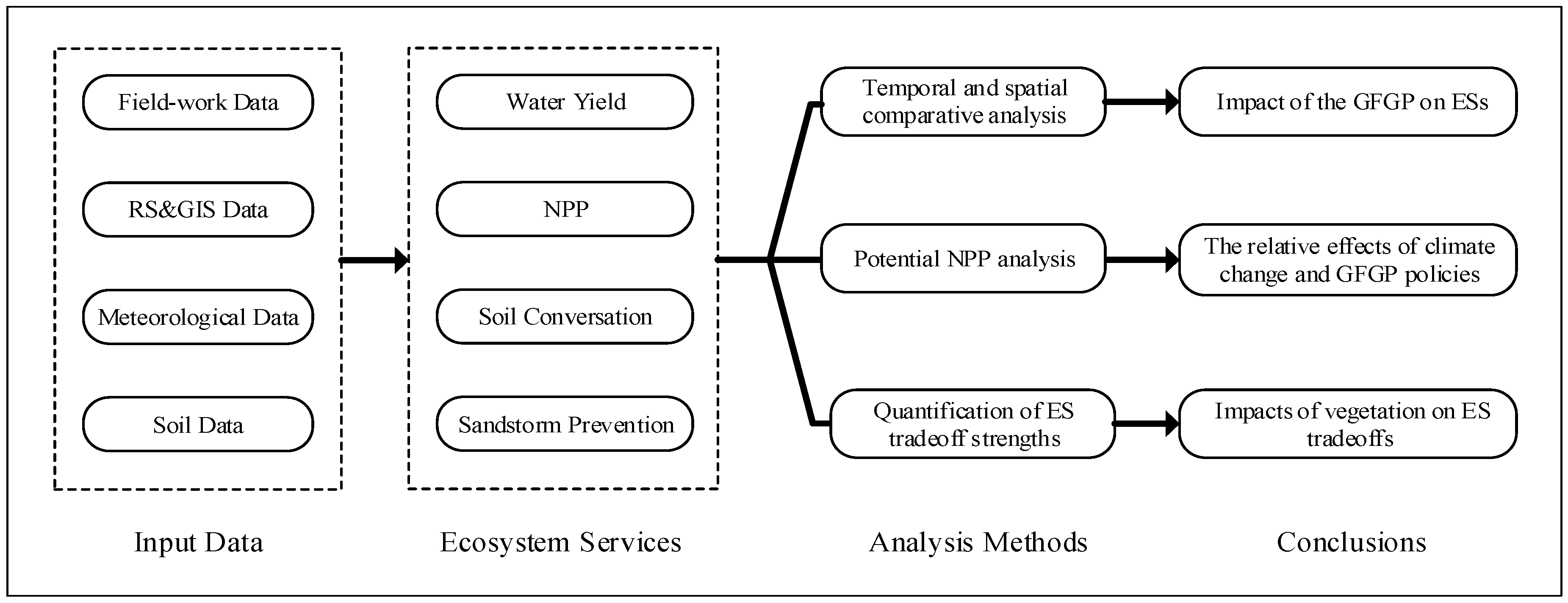
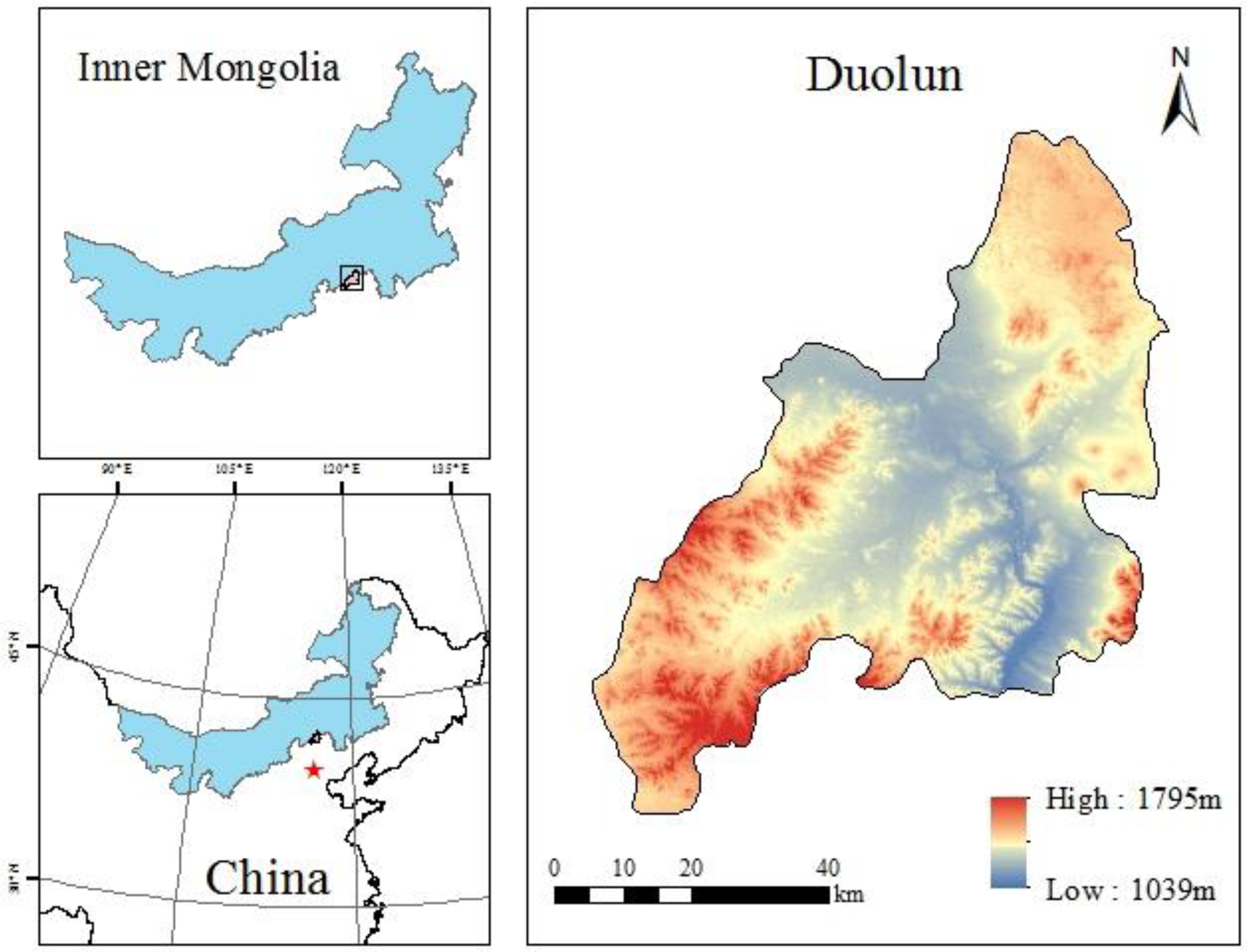
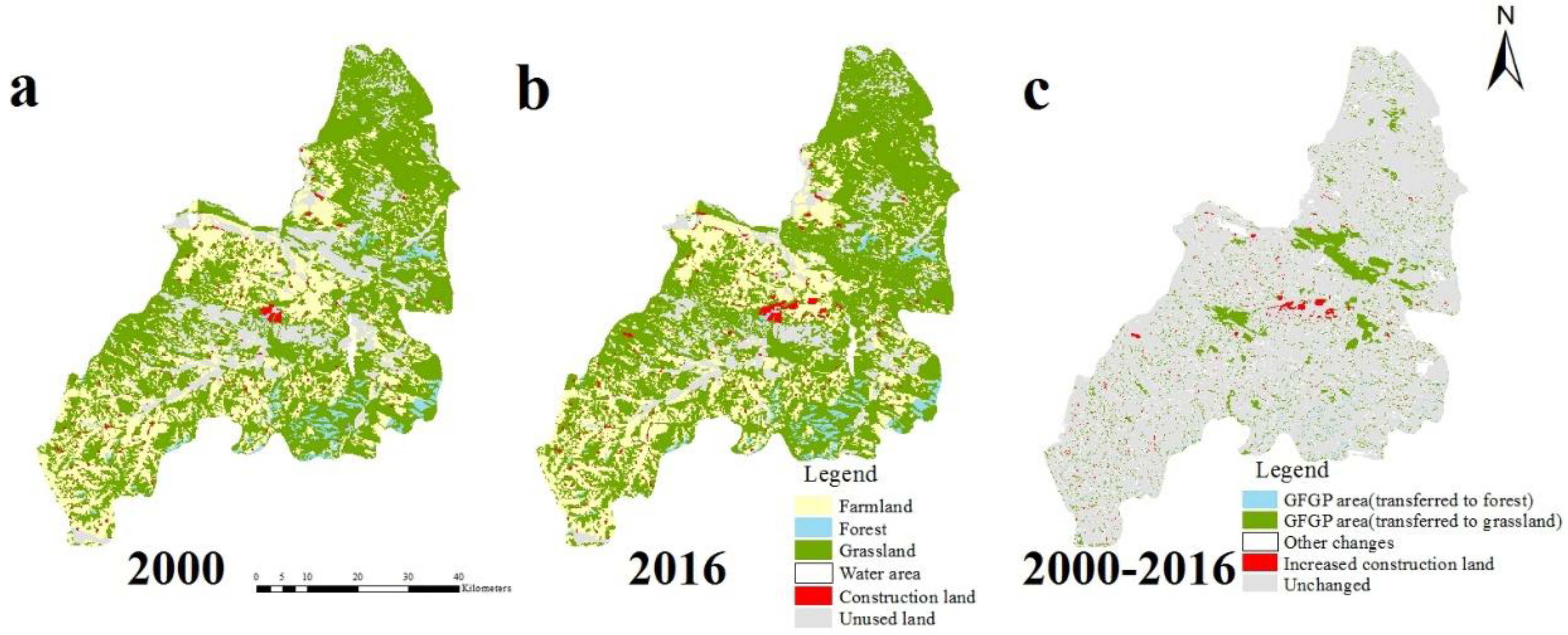
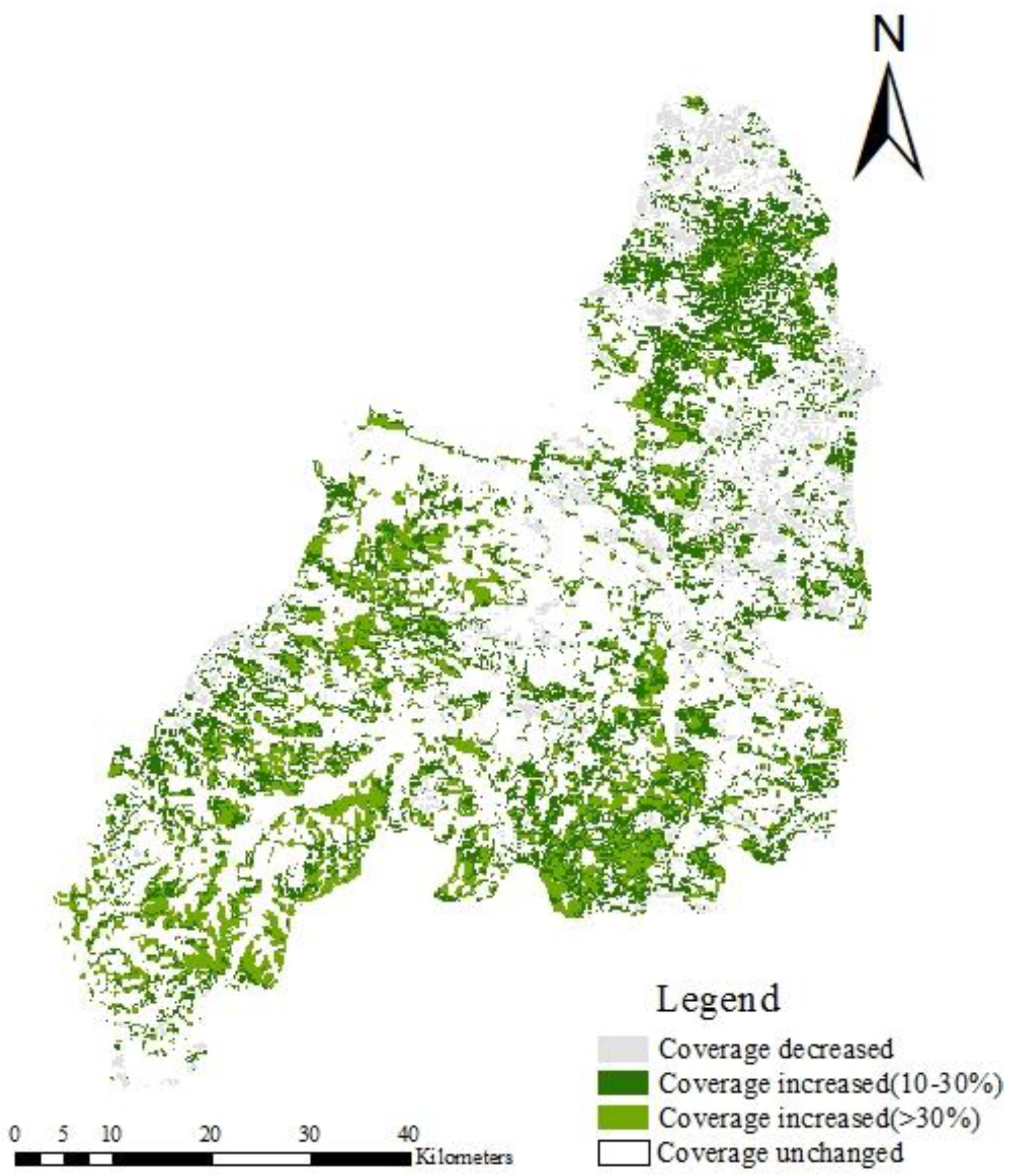
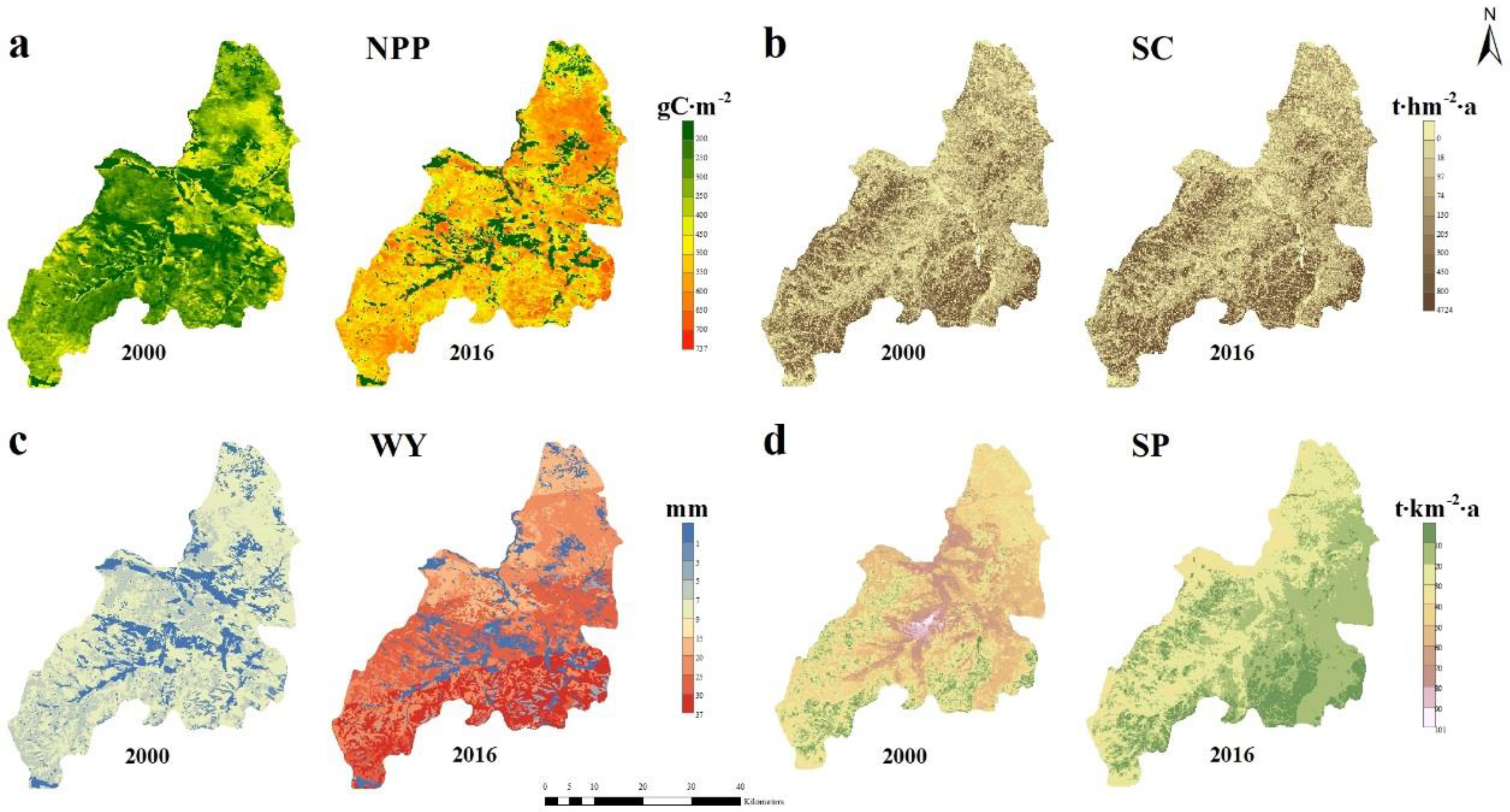
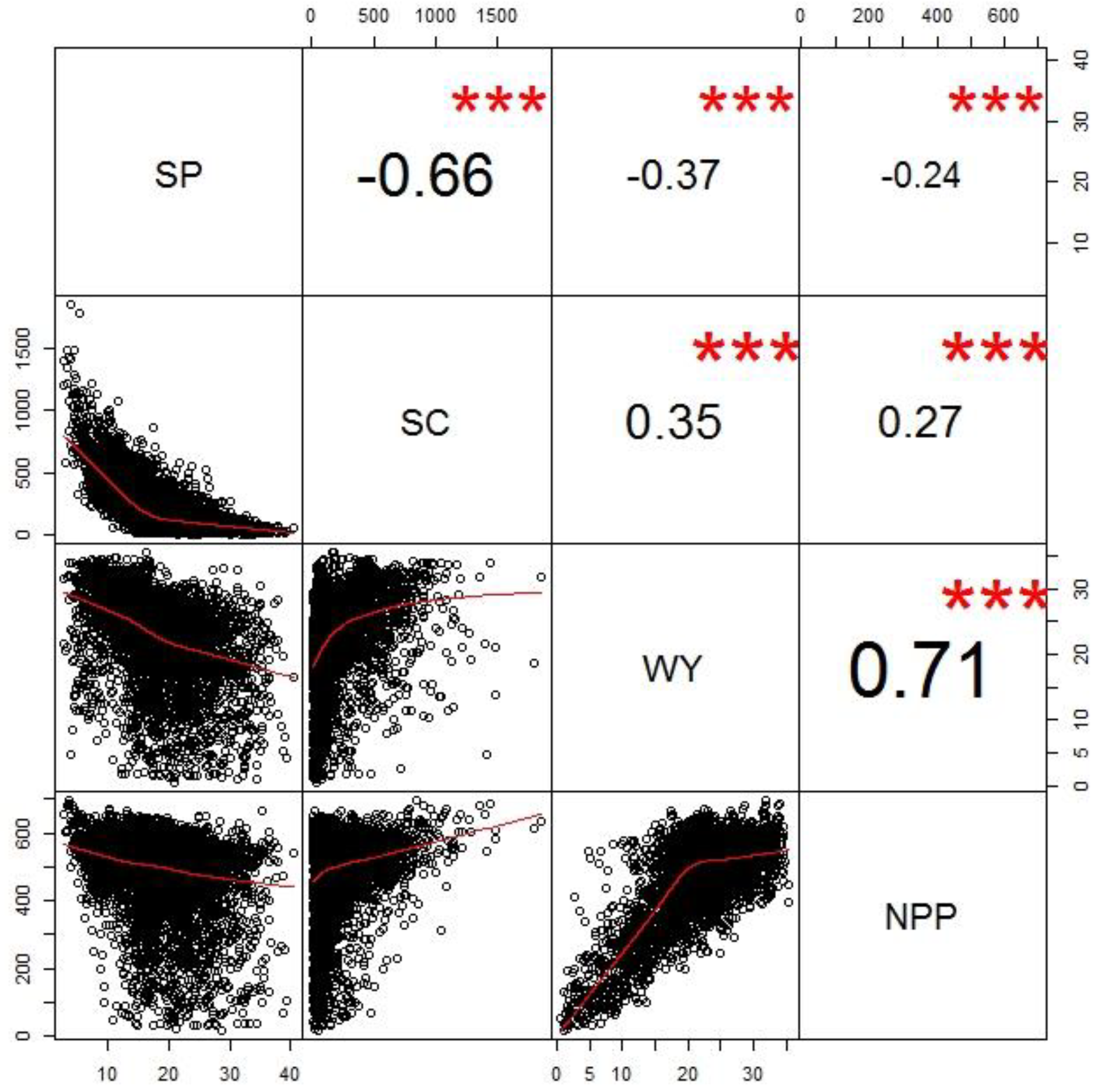
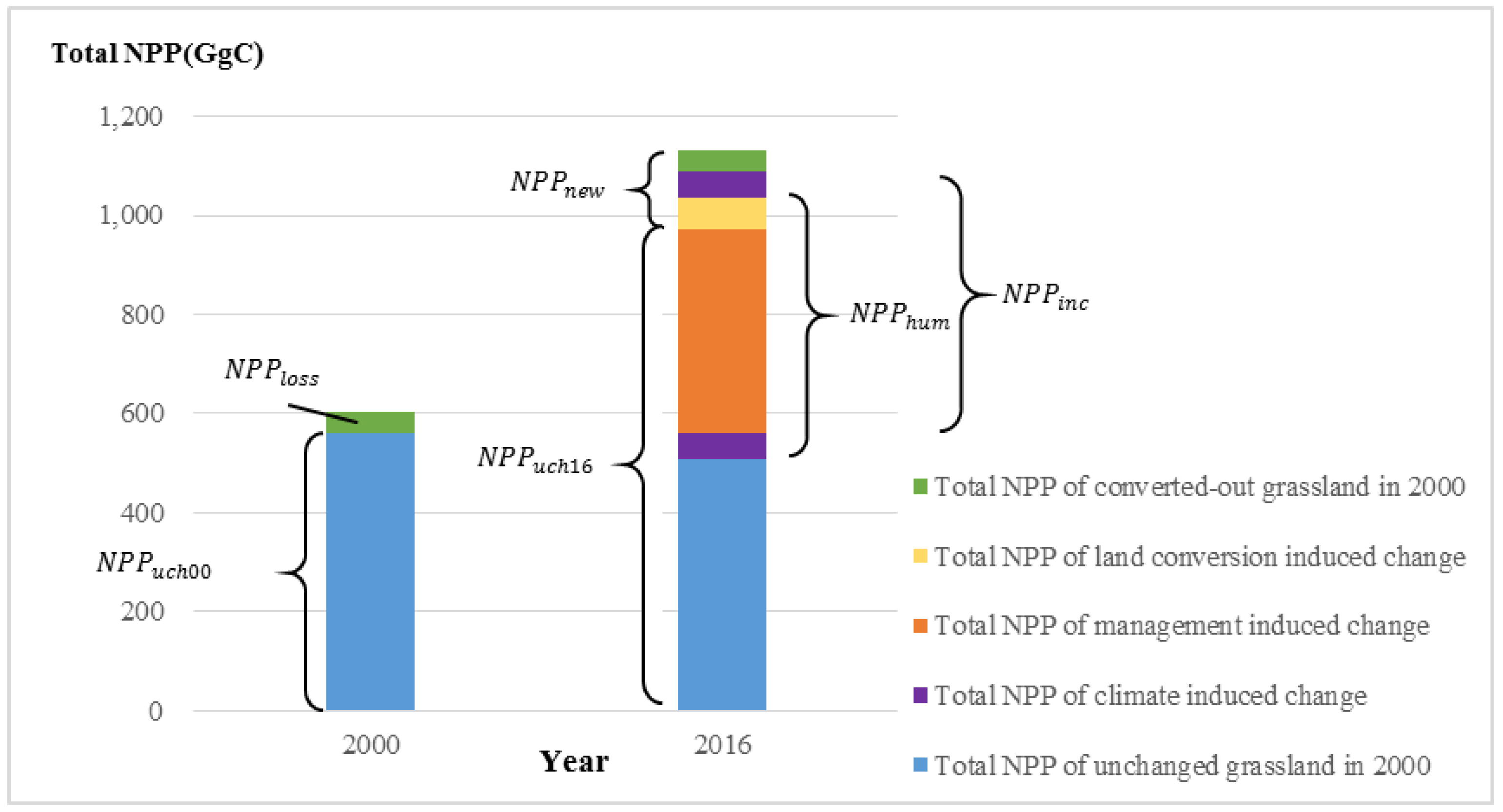
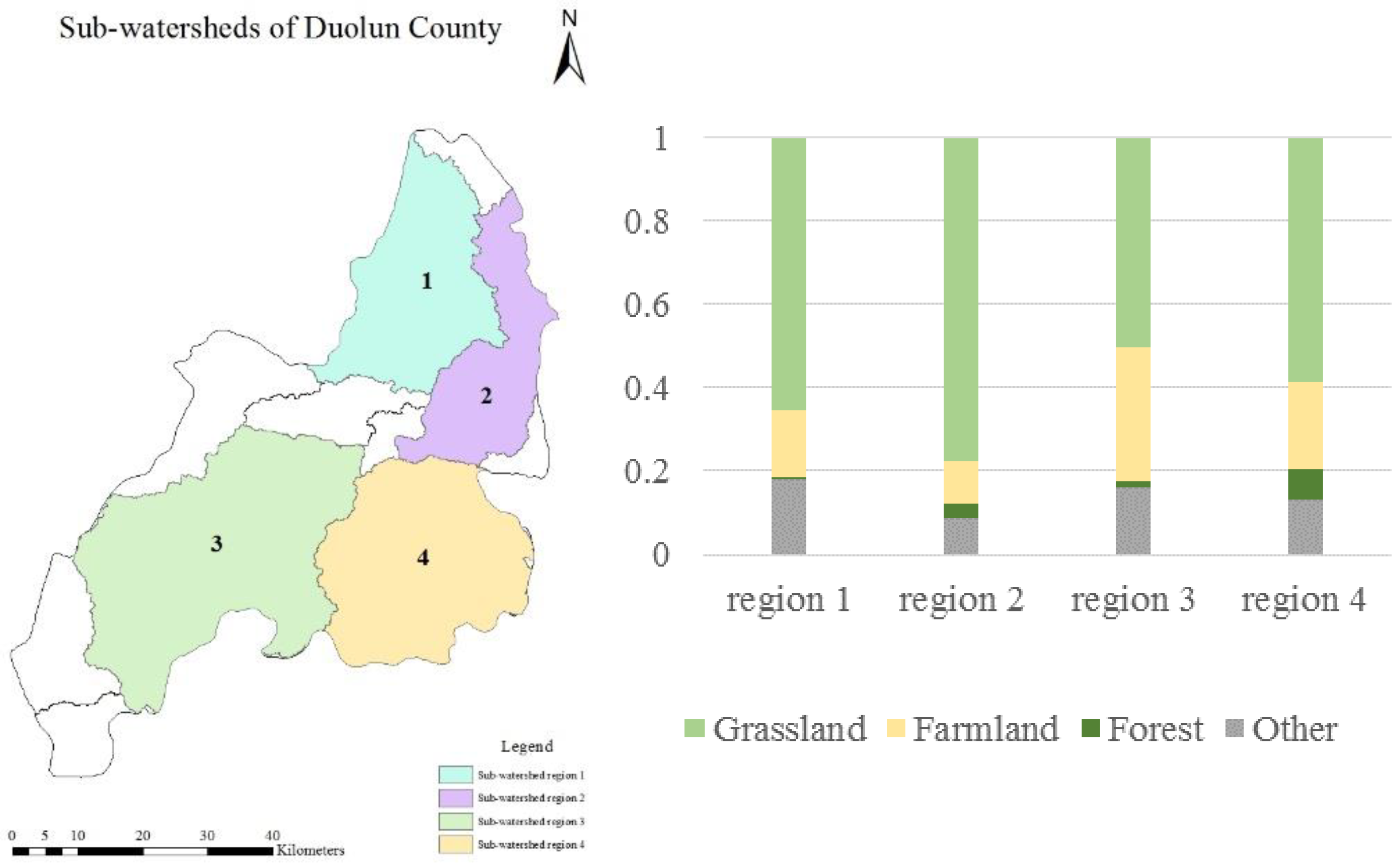
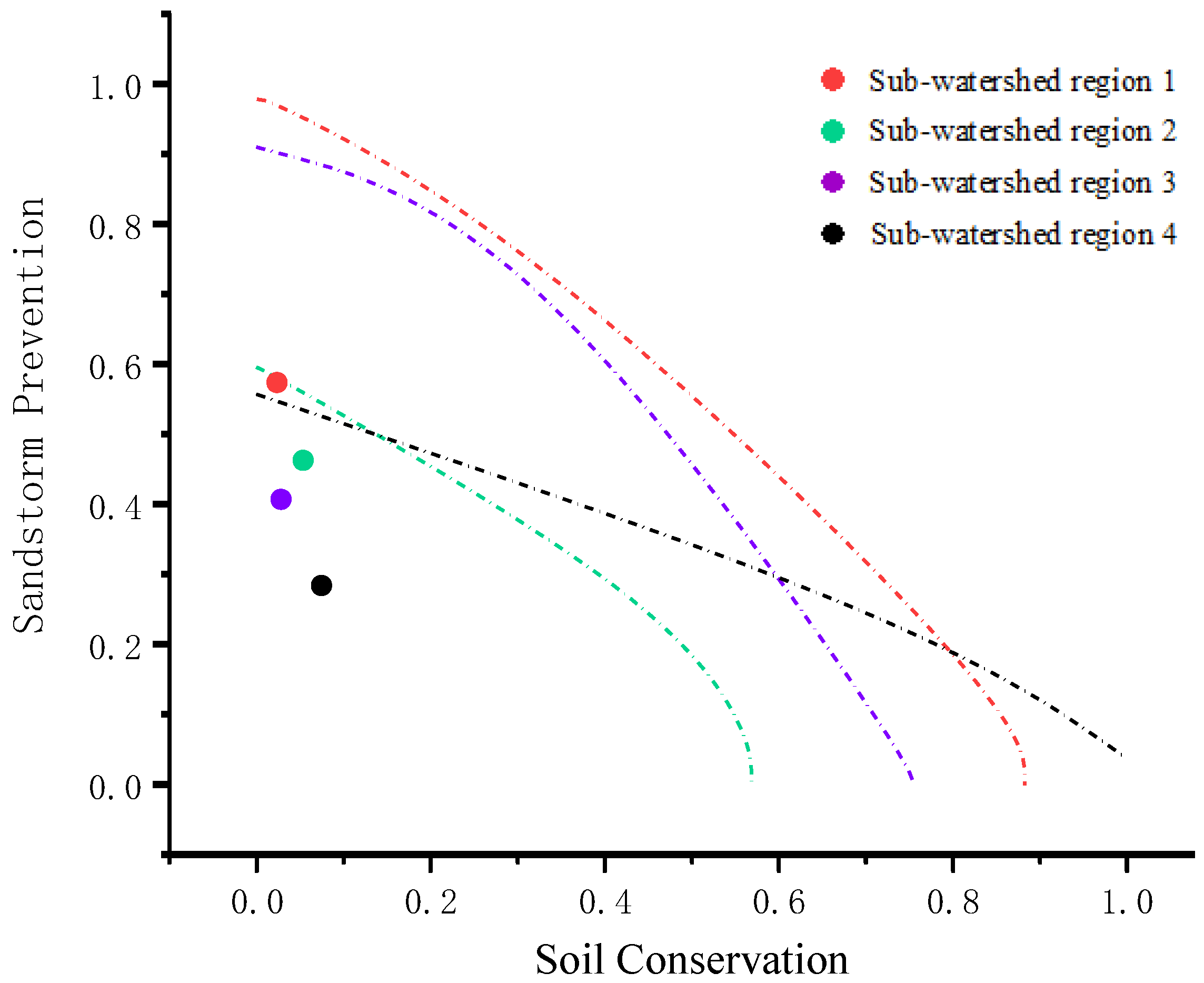
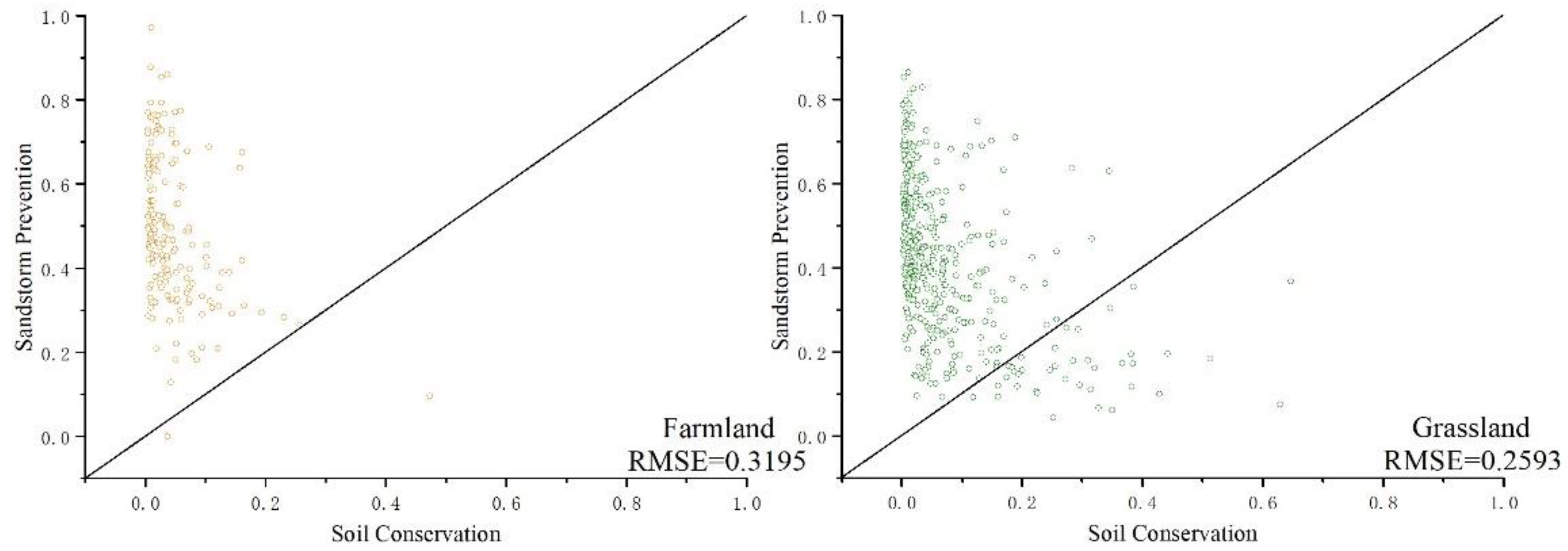
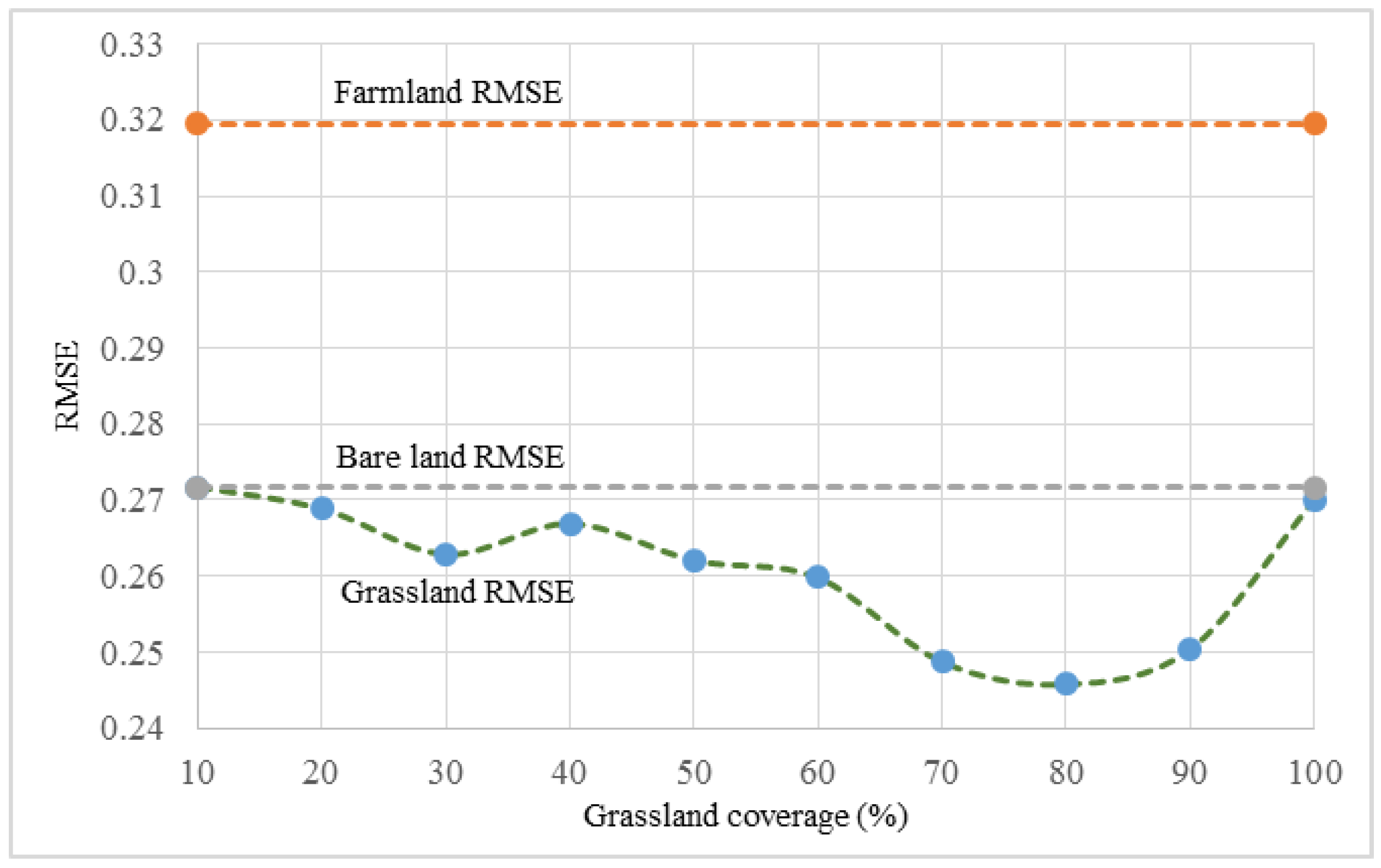
| Abbreviation | Description |
|---|---|
| ES | Ecosystem Service |
| GFGP | Grain-for-Green Programme |
| NPP | Net Primary Productivity |
| PPF | Production Possibility Frontier |
| RK | Rate of sandstorm prevention |
| RMSE | Root-Mean-Square Error |
| SC | Soil Conservation |
| SP | Sandstorm Prevention |
| WY | Water Yield |
| 2016 | Farmland | Forest | Grassland | Water Area | Construction Land | Unused Land |
|---|---|---|---|---|---|---|
| 2000 | ||||||
| Farmland | 893.36 | 4.23 | 159.19 | 0.66 | 12.88 | 16.30 |
| Forest | 2.71 | 75.37 | 16.08 | 0.07 | 0.20 | 1.43 |
| Grassland | 129.72 | 15.52 | 1890.86 | 2.34 | 14.18 | 66.53 |
| Water area | 0.70 | 0.09 | 3.25 | 17.32 | 0.03 | 0.67 |
| Construction land | 5.77 | 0.27 | 6.95 | 0.08 | 30.64 | 0.93 |
| Unused land | 24.26 | 0.40 | 181.82 | 1.10 | 2.53 | 368.34 |
| Year | Grassland | Ratio (%) | Forest | Ratio (%) | Farmland | Ratio (%) | Total | |
|---|---|---|---|---|---|---|---|---|
| NPP (GgC) | 2000 | 604.21 | 63.19 | 29.99 | 3.14 | 322.04 | 33.68 | 952.81 |
| 2016 | 1131.56 | 65.61 | 50.08 | 2.90 | 543.09 | 31.49 | 1719.24 | |
| SC (Mt) | 2000 | 46.57 | 69.81 | 5.62 | 8.42 | 14.52 | 21.76 | 66.71 |
| 2016 | 55.55 | 73.16 | 5.75 | 7.57 | 14.63 | 19.27 | 75.92 | |
| WY (Mt) | 2000 | 101.28 | 69.67 | 1.59 | 1.09 | 42.50 | 29.24 | 145.37 |
| 2016 | 358.90 | 70.47 | 6.48 | 1.27 | 143.94 | 28.26 | 509.32 | |
| SP () | 2000 | 85.20 | 62.42 | 2.45 | 1.79 | 48.84 | 35.78 | 136.48 |
| 2016 | 40.56 | 63.55 | 0.89 | 1.40 | 22.37 | 35.05 | 63.82 |
| Environment Factors | Marginal Effects (%) | Conditional Effects (%) |
|---|---|---|
| Precipitation | 10 | 10 |
| Clay content | 6 | - |
| Sand content | 4 | - |
| Silt content | 4 | 6 |
| Environment Factors | Marginal Effects (%) | Conditional Effects (%) |
|---|---|---|
| Soil organic matter content | 7 | 6 |
| Vegetation coverage | 4 | 3 |
| Clay content | 2 | 2 |
| NPP | SC | WY | RK | |
|---|---|---|---|---|
| Grassland coverage | 0.651 * | 0.057 * | - | 0.666 * |
© 2018 by the authors. Licensee MDPI, Basel, Switzerland. This article is an open access article distributed under the terms and conditions of the Creative Commons Attribution (CC BY) license (http://creativecommons.org/licenses/by/4.0/).
Share and Cite
Dang, D.; Li, X.; Li, S.; Dou, H. Ecosystem Services and Their Relationships in the Grain-for-Green Programme—A Case Study of Duolun County in Inner Mongolia, China. Sustainability 2018, 10, 4036. https://doi.org/10.3390/su10114036
Dang D, Li X, Li S, Dou H. Ecosystem Services and Their Relationships in the Grain-for-Green Programme—A Case Study of Duolun County in Inner Mongolia, China. Sustainability. 2018; 10(11):4036. https://doi.org/10.3390/su10114036
Chicago/Turabian StyleDang, Dongliang, Xiaobing Li, Shengkun Li, and Huashun Dou. 2018. "Ecosystem Services and Their Relationships in the Grain-for-Green Programme—A Case Study of Duolun County in Inner Mongolia, China" Sustainability 10, no. 11: 4036. https://doi.org/10.3390/su10114036
APA StyleDang, D., Li, X., Li, S., & Dou, H. (2018). Ecosystem Services and Their Relationships in the Grain-for-Green Programme—A Case Study of Duolun County in Inner Mongolia, China. Sustainability, 10(11), 4036. https://doi.org/10.3390/su10114036





